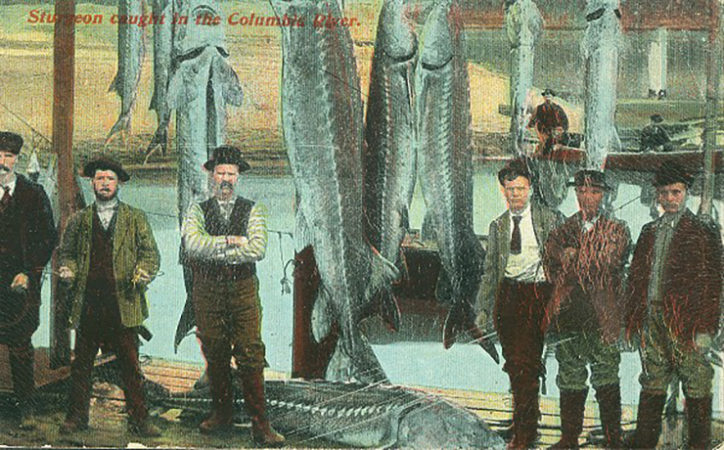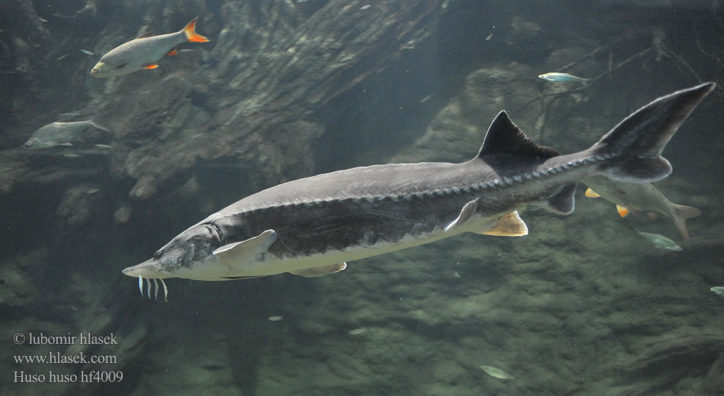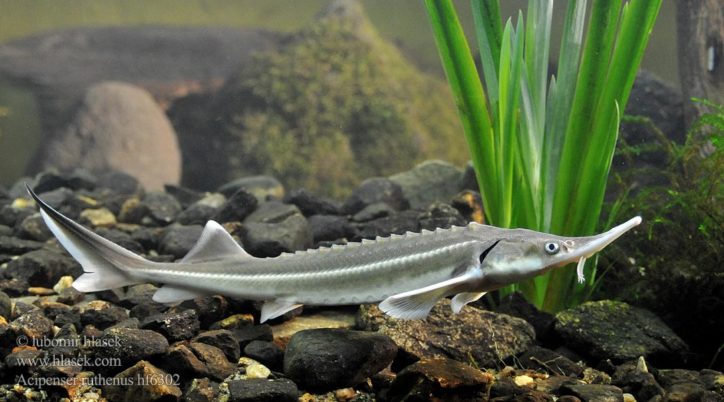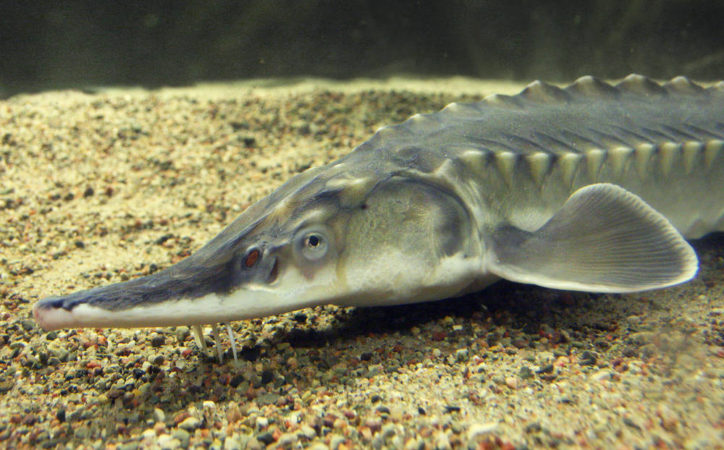Chondrostei, the subclass of Actinopterygii (ray-finned fishes), has already existed on the planet since the Paleozoic Era, so its modern representatives can be considered living dinosaurs for sure.

(Penny Postcard: Columbia River Sturgeon, ca.1910. columbiariverimages.com)
Representatives of Chondrostei existing nowadays can be up to 4.2 meters long (and according to some data unconfirmed by documentary sources, they can be even up to 8-9 meters long – beluga). Their body is covered with bony, ganoid tissue (containing ganoin, that is, glassy, often multi-layered mineralized tissue that covers scales, skull bones and fin rays in some fish), five rows of scutes (scutes are rows of bone shields characteristic of sturgeons) or may be bare.
Two modern orders comprise 41 species that exist nowadays.
However, their distant relatives, representatives of the Acipenseriformes order, comprising 28 existing species, inhabit only the waters of the Northern Hemisphere.
The order, in its turn, includes 2 families. Polyodontidae, inhabitants of the fresh waters of North America and China, are not found in Europe.
Representatives of the Acipenseridae family inhabit the Adriatic Sea and the freshwater bodies of the Balkan and Apennine Peninsulas. Sturgeons are, perhaps, the most legendary fish on the planet, apart from sharks. They have a peculiar bizarre body shape. That’s why, almost every person knows about them since childhood.
These fish have hard luck on the European continent. Uncontrolled fishing, rush toward sturgeon roe, in addition to the construction of dams on the rivers, where they swam or used to swim for spawning, caused to their disastrous state nowadays.
Until recently, we could confidently consider the following fish species of the sturgeon family to be related to the Adriatic region:

(Beluga. Photo by © Lubomir Hlasek. hlasek.com)
It is an anadromous pelagic species. It inhabits sea waters at depths of 70-180 meters. It spawns in large rivers, in which juveniles live throughout the first year of life. According to some sources, the recorded maximum length is 420 cm. According to other sources, the fish can grow up to 900 cm. Specimens up to 200 cm are more common. The maximum weight is 3,200 kilograms. It feeds on medium-sized fish, crustaceans, mollusks and polychaetes.
Most likely, the population, which previously inhabited the Adriatic Sea, no longer exists. The latest records from Croatia, where beluga swam for spawning in the Sava River, date back to the middle of the previous century. The last time it was seen in the Po River, Italy, the main breeding site of the Adriatic beluga, was in 1972. The current of the Danube in Serbia below the dam of the Iron Gate I Hydroelectric Power Station, where its population is in danger of passing away as well, is the closest place from the Adriatic coast, where there are still chances to meet this magnificent fish.
It is listed in the IUCN Red List as a species remaining in critical condition (CR).
Adriatic sturgeon (Acipenser naccarii).

(Adriatic sturgeon. Photo by © Drow male. wikipedia.org)
It is a diadromous fish. In the sea, it sticks to the pre-mouth areas of large rivers, usually 10-40 meters deep. In the rivers, it lives in deep areas with a muddy and sandy bottom. The recorded maximum length is 200 cm. The maximum weight is 25 kilograms. It feeds on bottom invertebrates and small fishes.
It used to be a common species in the basin of the Adriatic Sea. Nowadays, it is extremely rarely found and, perhaps, it is almost extinct. Attempts to restore the population are being made. Single encounters have been recorded in the Po River (Italy) and its tributaries (Ticino, Adda, Oglio, Mincio), as well as in the Adige, Livenza, Piave, Tagliamento Rivers. The last encounter with the Adriatic sturgeon at the mouth of the Bojana (Buna), the river that flows along the border between Montenegro and Albania, was recorded in 1997.
It is listed in the IUCN Red List as a species remaining in critical condition (CR).

(Sterlet. Photo by © Lubomir Hlasek. hlasek.com)
It inhabits the rivers of the basins of the Black Sea, the Sea of Azov and the Caspian Sea. It sticks to the bottom of deep areas of rivers, with a strong current as a rule. The recorded maximum length is 125 cm. Specimens up to 40 cm long are more common. The maximum weight is 16 kilograms. It feeds on maggots, scuds, caddis flies, as well as mollusks, leeches and small fish.
It inhabits the Danube and its major tributaries (the Sava, Drava, Mura Rivers, etc.) flowing through the territories of Bosnia and Herzegovina, Slovenia and Croatia.
It is listed in the IUCN Red List as a vulnerable species (VU).
Atlantic sturgeon (Acipenser sturio).

(Atlantic sturgeon. Photo by medioambiente.net)
It is a diadromous fish. It inhabits sea waters at the depths of 4-95 meters, usually 5-60 meters deep. It spawns in large rivers and their pre-mouth areas. Juveniles live here for the first few years. The recorded maximum length is 600 cm. Individuals up to 125 cm long are more common. The maximum weight is 400 kilograms. It feeds on crustaceans, mollusks, polychaetes and small fish.
Most likely, it is extinct in the Adriatic Sea and the rivers of the basin. It used to swim to the Po, Soca, Neretva, Drin, Buna (Bojana) and other rivers. Recent records of encounters with the Atlantic sturgeon are dated 1998 in the Buna (Bojana) River and 1994 in the Po River.
It is listed in the IUCN Red List as a species remaining in critical condition (CR).